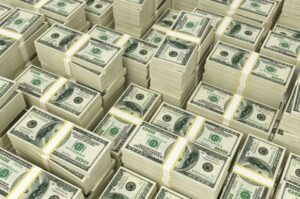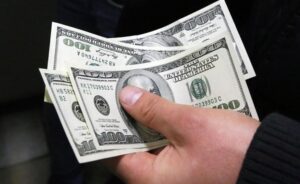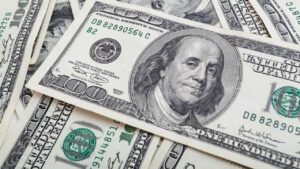
The U.S. dollar is stable against the euro in trading on Friday, getting stronger against the pound and cheaper against the yen.
Traders will focus on the U.S. labor market report for November, which will be released at 3:30 p.m. Ksk.
The consensus forecast of experts polled by Trading Economics expects the number of jobs in the U.S. economy to increase by 200,000 in November and unemployment to remain at 3.7%.
The November labor market report is important to the Federal Reserve (Fed), which will hold its next meeting on December 13-14. Judging by futures quotations for the prime rate, the market expects the Fed to raise it by 50 bps. – to 4.25-4.5% per annum.
A new dot plot of forecasts will also be published at the end of the December meeting, reflecting the individual expectations of the members of the Federal Reserve Board of Governors and the heads of the Federal Reserve Banks with regard to interest rates.
Earlier this week, U.S. Central Bank Chairman Jerome Powell confirmed that the Fed could slow its rate hike as early as December.
Fed Vice Chairman of Banking Supervision Michael Barr on Thursday also argued in favor of a slower rate hike.
“We’ve been moving very, very quickly toward a rate level that would limit economic activity, and now that we’re very close to it, I think it makes sense to slow the pace of the hike,” Market Watch quoted Barr as saying.
The euro/dollar pair was trading at $1.0529 as of 8:20 a.m. Ksk Friday, up from $1.0527 at the close of the previous session. The pound fell to $1.2239, compared to $1.2256 at the close of trading on Thursday.
The dollar-yen exchange rate declined to 135.08 yen in trading, compared to 135.34 yen at the close of the previous session.
The ICE-calculated index showing the dollar’s dynamics against six currencies (euro, Swiss franc, yen, Canadian dollar, pound sterling and the Swedish krona) lost 0.01% on Friday, while the broader WSJ Dollar Index lost 0.04%.

The U.S. dollar is stable against the euro and the yen in trading on Friday, strengthening against the pound sterling.
A day earlier, the dollar fell in price against the world’s major currencies after the publication of the minutes of the Federal Reserve (Fed) meeting in November, which showed that the overwhelming majority of the U.S. central bank sees the need to slow the pace of rate hikes in the near future.
The ICE index showing the dollar’s performance against six currencies (euro, Swiss franc, yen, Canadian dollar, pound sterling and Swedish krone) lost 0.17% on Friday, while the broader WSJ Dollar Index was steady.
The euro/dollar pair is trading at $1.0411 as of 8:10 a.m., up from $1.0413 at the close of the previous session.
The dollar is trading at 138.66 yen against 138.64 yen the day before. The pound fell to $1.2099 from $1.2117.
On Thursday, the dollar fell 0.2% against the euro, 0.7% against the yen and 0.5% against the pound.
“Some of the Fed leaders observed that monetary policy had reached a state in which it was sufficiently restrictive to meet FOMC goals and it would be appropriate to slow rate hikes. The vast majority of meeting participants felt that a slowdown in the pace of the hike would probably be appropriate soon,” the minutes of the Nov. 1-2 Fed meeting noted.
Some of the U.S. central bank leaders, meanwhile, believed that the Fed would have to raise the rate higher than previously planned in order to meet its goal of easing inflation.
They indicated that the rate “will have to reach a somewhat higher level than previously expected,” given the lack of sufficient signals of easing inflation in the U.S. at the moment, as well as the continuing imbalance of supply and demand in the economy.

The U.S. dollar is getting cheaper against the euro, is stable against the British pound and rises against the Japanese yen in trading on Wednesday morning.
The ICE-calculated index showing the dollar’s dynamics against six currencies (euro, Swiss franc, yen, Canadian dollar, pound sterling and Swedish krona) is losing 0.13%, while the broader WSJ Dollar is down 0.03%.
The focus for traders this week is the minutes of the Federal Reserve’s November 1-2 meeting, at which the U.S. central bank raised its benchmark interest rate by 75 basis points (bps) and hinted at the possibility of a slowdown in its rate hike.
The minutes of the meeting will be published on Wednesday at 9 p.m. The experts expect the report to show that the Fed’s leaders reached a consensus on the need to slow the rate hike, Bloomberg wrote. However, there’s no consensus among them as to what interest rate cap will start to slow economic activity and lower the rate of inflation.
The euro/dollar pair is trading at $1.0329 as of 8:30 Moscow time, down from $1.0306 at the close of the previous session.
The dollar rose to 141.34 yen in trading against 141.22 yen on Tuesday.
The pound exchange rate was stable at the level of $1.1887 at the close of the previous session.
Meanwhile, the Chinese yuan was falling 0.19% against the dollar to settle at 7.1541 yuan per $1 as of 8:40 Moscow time. Investors are worried about new lockdowns in major Chinese cities because of a new outbreak of the coronavirus in the country which may trigger a slowdown in economic growth.

The US dollar is getting cheaper against the euro, the yen and the pound sterling in trading on Tuesday after the previous session’s strengthening following another Federal Reserve (Fed) statement.
This week, traders will focus on the Federal Reserve’s minutes of November 1-2 meeting at which the U.S. central bank raised its benchmark interest rate by 75 basis points (bps) and hinted at a possible slowdown in the rate hike.
The minutes of the meeting will be released Wednesday at 9 p.m. ET.
On Monday, Federal Reserve Bank (FRB) presidents Loretta Mester and Mary Daly of Cleveland and San Francisco signaled that the U.S. central bank would slow the pace of prime rate hikes next month, while stressing that the need for further policy tightening remains.
“I believe we can slow down the rate hike at the next meeting, I don’t see a problem with that,” Mester told CNBC. – However, I don’t think we’re close to pausing.”
For her part, Daley said the Fed should be mindful of the time lag between Fed decisions and their impact on the real economy. At the same time, she reiterated that she sees the need to raise the rate to at least 5%.
The ICE-calculated index showing the dollar’s performance against six currencies (euro, Swiss franc, yen, Canadian dollar, pound sterling and Swedish krona) lost 0.18% on Tuesday, while the broader WSJ Dollar lost 0.17%.
The euro/dollar pair is trading at $1.0259 as of 8:15 a.m., up from $1.0243 at the close of the previous session.
The dollar traded down to 141.78 yen from 142.14 yen on Monday.
The pound rate rose to $1.1851 compared to $1.1824 the day before.

The dollar is moderately depreciating against the euro and appreciating against the yen on Wednesday morning as investors assess geopolitical risks and U.S. inflation data.
The ICE-calculated index, which shows the U.S. dollar’s performance against six currencies (euro, Swiss franc, yen, Canadian dollar, pound sterling and Swedish krona), is up less than 0.1%, as is the broader WSJ Dollar Index.
The day before, the dollar index had fallen to a three-month low on further signals of slowing U.S. inflation.
As it became known on Tuesday, producer prices in the United States (PPI) rose 8 percent year-over-year in October and 0.2 percent against September. Analysts polled by Trading Economics forecasted an average increase of 8.3% for the former index and 0.4% for the latter.
Meanwhile, Rafael Bostic, head of the Federal Reserve Bank (FRB) in Atlanta, expressed the view that the Fed should continue to raise interest rates until there are signs of widespread easing in inflation. “We haven’t seen that yet, so I believe we will need new rate hikes,” Bostick wrote. He added, however, that he sees “glimmers of hope” in the past three months, but prices are falling mostly for goods, not services.
The currency market is also reacting to news of a rocket explosion in Poland, which killed two people. A number of media outlets wrote that the missile could have come from Russian territory.
However, Polish President Andrzej Duda said the government could not yet confirm who fired the missile, and U.S. President Joe Biden said it was unlikely that it came from Russian territory.
The Russian Defense Ministry denied that the rockets were Russian, saying that the military had not struck any targets near the Ukrainian-Polish border.
The euro/dollar pair was trading at $1.0370 by 7:52 a.m., versus $1.0350 at the close of Tuesday’s session, with the euro strengthening 0.2%.
The dollar/yen is up 0.4% at 139.82 yen, up from 139.31 yen at the end of last session.
The pound is stable and trading at $1.1865.

The dollar is weakening against the euro and is recovering against the yen after a sharp drop against almost all world currencies the day before, triggered by data on a significant weakening of inflation in the United States.
As it became known on Thursday, consumer prices (CPI) in the United States rose by 7.7% in October against the same month last year after an increase of 8.2% in September. Thus, inflation slowed to its lowest since January and was well below market forecasts.
The data may affect the policy of the U.S. Federal Reserve (Fed), which is aggressively raising interest rates in an attempt to curb inflation.
The head of the Federal Reserve Bank (FRB) of Philadelphia, Patrick Harker, already spoke in favor of slowing further rate hikes.
“In the coming months, in light of the cumulative tightening (of QE – IF) already achieved, I expect the pace of rate hikes to slow down as we get closer to sufficiently restrictive policy,” Harker said during a speech at an event in Philadelphia.
The ICE-calculated index, which shows the U.S. dollar’s performance against six currencies (euro, Swiss franc, yen, Canadian dollar, pound sterling and Swedish krona), is down 0.25 percent. The day before, the indicator was down 2%.
The euro/dollar pair is trading at $1.0218 by 7:55 a.m. Ksk, versus $1.0209 at the close of Thursday’s session, with the euro strengthening 0.1%.
The dollar/yen is up 0.4% at 141.57 yen, up from 140.97 yen at the end of last session.
The pound is changing little and is trading at $1.1716 compared to $1.1715 at the close of previous trading.
The mainland yuan rose 1.1 percent to 7.1089 yuan per $1, renewing a four-week high.
The Australian dollar is up 0.5 percent at a seven-week high of $0.67, despite statements by Australia’s Deputy Central Bank Governor Michelle Bullock that the country’s interest rate is likely to continue rising.